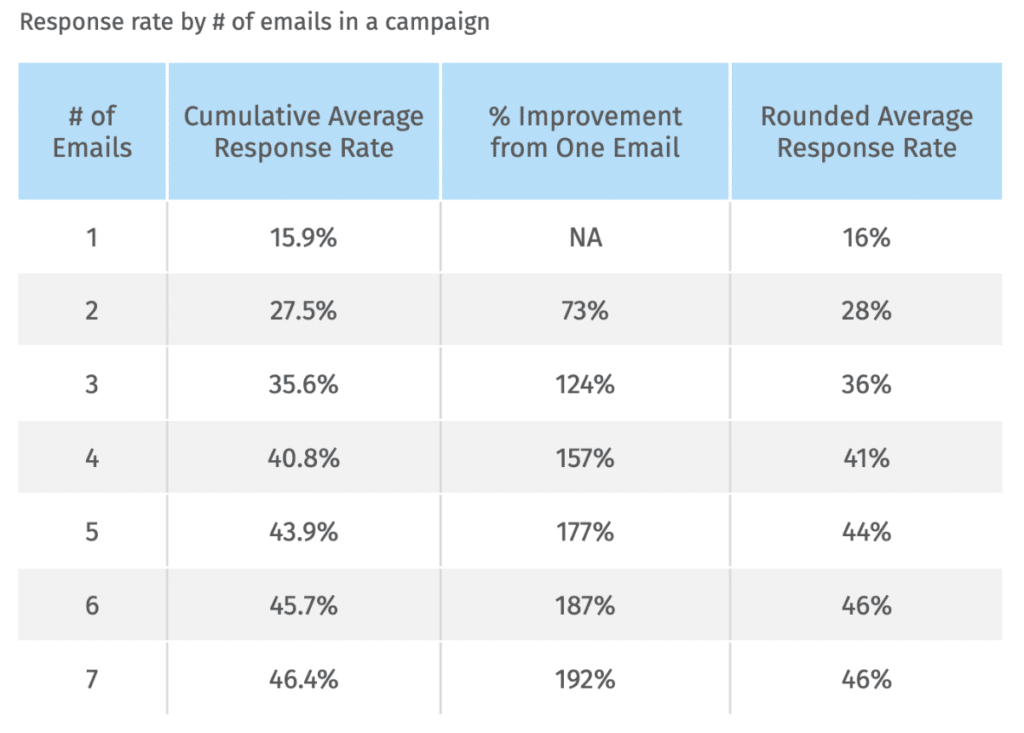Candidates are getting harder to reach and less likely to apply for jobs than previous years. Certain fields are in even more high demand. For example, more than 5 million jobs in information technology are expected to be added globally by 2027. IT is one of the most competitive areas, with many companies competing to hire knowledge workers.
But if candidates aren’t applying anymore, what do you need to do to get in front of the next wave of talent and convince them to join your workforce? The following four ideas can help in the coming year.
#1: Hunt and nurture strong talent
The challenge:
Candidates aren’t applying to jobs like they used to. And with the number of unemployed persons per job opening at 0.9, this may not change anytime soon. Therefore, employers need to go outbound to reach candidates and lure them to come and work for you.
The solution:
Send more than one outreach email and consider an omnichannel approach to reaching your candidates. Lever research shows that sourcing candidates is 2x more efficient than relying on applicants. And that nurturing increases the number of sourced hires by 40%. Where a single email from a recruiter gets an average response rate of 16%, a simple three-email campaign boosts that to 36% — and a full six-email nurture can get that up to 46%.
Text can also improve results, depending on the roles you are hiring for, with an average open rate of 98%. Consider adding text to your strategy to make an impact for certain roles and/or stages and to help eliminate the black hole, especially for high-volume roles. (To learn more about how Renewal by Andersen was able to up-level their communications to meet candidates where they are, check out their story here.)
#2: Ditch spreadsheets to move faster
The challenge:
Collaborating in spreadsheets leaves a lot of room for human error, making it almost impossible to manage over time and keep track of top talent. Especially when you’re entering a phase of high growth (or needing to pull metrics for reporting).
The solution:
Ensuring that your tech stack is simple and seamless and that information can flow through different systems can make a big difference to both time and cost savings. For example, digital marketing solutions company Centro saw a huge boost in productivity when they reduced their recruitment technology stack to their HRIS and applicant tracking system.
“Since we are a digital media technology, we wanted a system that used technology to improve some of the strategic tasks we give our team,” says Elles Skony, Vice President of Talent Management at Cento. “Like going outbound to source qualified talent, aggregating all hiring information to one candidate profile, and syncing all candidate communications and feedback to one place for transparency. We also wanted to improve the hiring manager experience.”
Since post-hire data is just as important as pre-hire data, Centro appreciates that with Lever Talent Cloud Connect, the company can immediately spot check their most successful hiring sources. The team can now see which hires are needed, keep track of top candidates, and proactively manage planning to get ahead. The system can even recommend ideal candidates for roles when the timing is tight, saving the team time and money in the process.
#3: Allow for remote work and talent mobility
The challenge:
Since the competition for talent is fierce, candidates are more selective on the perks of where they want to work. With companies like Shake Shack announcing expansion for their four-day work week test, companies need to start walking the walk for more inclusion and flexibility in the workplace.
The solution:
Video technology is now being used by 60% of hiring managers and recruiters. A survey of 506 companies showed 47% use video interviewing to shorten the hiring timeframe, and 22% would consider it for interviewing candidates that aren’t local. Putting technology in place to allow for flexibility when the right candidate comes along can ensure you don’t miss out on a great hire. Lever recently announced we’re the first ever ATS to allow for Zoom capability when you schedule the interview, so that you don’t miss a beat.
To learn more about which roles can and can’t be made remote, check out our helpful guide 5 Steps to Hiring and Building a Remote Culture, featuring talent thought-leader Brennan Smith from Welocalize.
#4: Measure and report on candidate quality
The challenge:
Candidate quality can be a tough thing to measure and report on because it requires pre- and post-hire systems to integrate and funnel data back and forth. But it’s worth achieving to help your team make more educated decisions on how and where you hire.
The solution:
Partner with a recruiting system that enables you to automate dissecting data and integrates with your HRIS offering. There are also steps you can take to mitigate rejected candidates late in the funnel or high churn once a candidate starts. Ensure that you are setting job criteria at the start for what makes a quality candidate in any given role. At Lever, we use impact descriptions instead of job descriptions to motivate new hires and keep them inspired and focused throughout their first year.
Secondly, ensure there’s a screening process that surfaces any red flags during interviewing. We have a Definitive Guide of over 101 interview questions to ask to ensure you prep interviewers to screen for the right areas during your process.
Lastly, come up with a baseline measurement for quality hires. Is it impacting the organization, tenure, etc.? Ensuring employees reach and sustain their max potential for your organization and iterating on that strategy enables talent leaders to drive and sustain solid growth revenues for your organization.
Final thoughts: Overcoming hiring challenges in 2020
New hiring challenges are causing talent leaders to think and forecast like a sales leader, reach and close talent like a marketer, and gain insight into all of their talent attraction efforts like a finance leader. Companies are also turning more and more to talent leaders to grow the business. Having the right technology partners at your side to meet these changing demands will only become more important in the early years of this new decade.
To see how Lever can help solve your key recruiting challenges in 2020 and beyond, request a demo.

